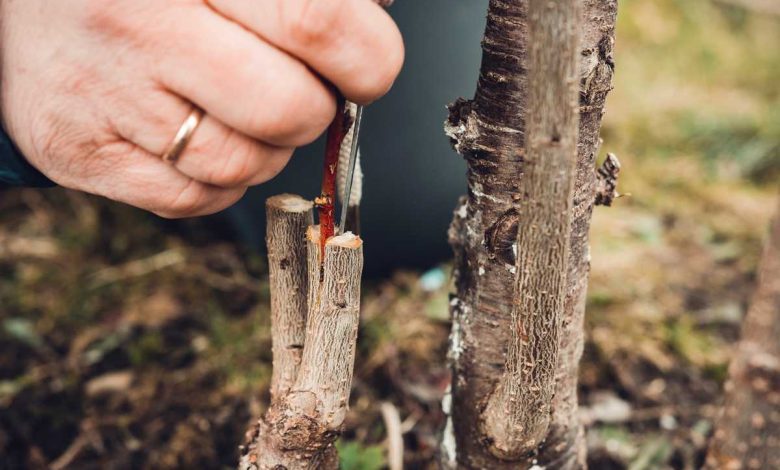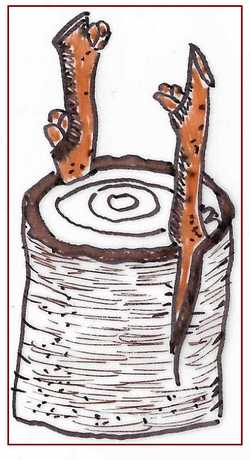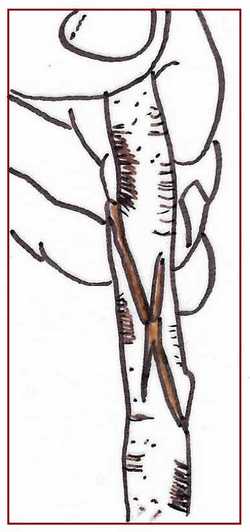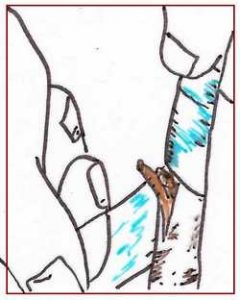
Often scary for beginners, grafting fruit trees is easier than it looks! This technique makes it possible to quickly multiply an excellent variety of fruits . Depending on the species, the grafts are carried out at the end of winter or at the end of summer.
What is tree grafting?
The grafting or grafting of a fruit tree is a technique that brings the tissues of a part of a plant (the graft) into contact with those of a host tree (the rootstock).
For grafting to be successful, care must be taken to choose a compatible rootstock and scion . They are usually of the same species. For example, apple tree scions will be united with rootstocks from seedlings of apples.
But there are some exceptions. For example, pear trees (Pyrus) are often grafted onto another species: quince (Cydonia).
It is also necessary to take care to always leave the grafting point in the open air and not to bury it.
Why transplant a fruit tree?
While sowing gives trees with random characteristics, grafting makes it possible to obtain a clone of the multiplied variety, with all its qualities.
This technique is used when cuttings and layering (2 other faithful reproduction techniques) are difficult or do not give good results, which is generally the case with fruit trees.
The choice of the appropriate rootstock is essential because it is this which makes the connection between the soil and the graft. It is therefore he who feeds it.
The rootstock:
- Offers more or less vigor to the new plant. This vigor must be adapted to the form. Thus, a high-stemmed tree needs a vigorous rootstock whereas it must be more reduced for a fruit tree led in goblet or for a dwarf fruit tree.
- Allows the cultivation of the fruit species on certain soils known to be difficult, in particular calcareous soils.
- Can save a few years on fruit set . Thus, a grafted variety will bear fruit earlier, and you will not have to wait for many years.
2 major grafting periods
The best time to graft the most common pome fruit trees such as apple and pear is at the end of winter, in February and March. This period corresponds in fact to a resumption of vegetation with a significant surge of sap.
For this, it is necessary to have taken the grafts during the period of rest of vegetation, in winter. These small branches with buds are then kept in the cold, half buried in the ground or compost at the foot of a wall facing north, while waiting for the grafting.
To practice the grafting of stone fruit trees such as peach, it is best to wait until the end of summer.
In cleft, English… Several types of grafts!
The success of grafting depends very much on the conditions offered. It is necessary to prevent the root system from becoming dehydrated by very regular watering and also to provide an ambient temperature favorable to the union of the scion and its rootstock. This fragile connection is also protected by covering it with mastic or healing strips.
Cleft or inlay graft
It is practiced in February-March on young rootstocks, measuring less than 4 cm in diameter at most. The basic technique is to make a slit 3 to 4 cm deep in the center of the main stem of the rootstock, at its top. The base of the graft is then prepared by re-cutting it at an angle to introduce it into this slot. Care must be taken to leave part of the wound exposed to the open air to obtain better healing.

Slit grafting is well suited for cherry trees, apple trees, vines, chestnut trees, etc.
Crown graft
It is practiced a little later, in March or April, on rootstocks or adult trees, the diameter of which is too large to be split-grafted . The grafts are arranged on the periphery of the trunk in contact with the tissues causing the sap to rise, hence the name crown given to this type of grafting.

Crown grafting is well suited to apple trees, pear trees, plum trees, olive trees, fig trees… But peach trees cannot be grafted this way.
English graft
This traditional method of grafting fruit trees is less and less practiced. It consists of cutting the rootstock and the graft at an angle until an oblique section of about 4 cm in length is obtained.
These two sections are then brought into contact so that they unite while healing.
To facilitate and increase the chances of success, the graft should be pruned just below a bud.

To make the two parts hold together well, you can make a small vertical slit on each before assembling them.
The English graft is well suited for all fruit trees, especially vine, quince and apricot.
Graft in escutcheon or escutcheon
This traditional method of grafting involves inserting a bud of the scion behind the bark of the rootstock so that the base of the bud is in direct contact with the tissues of the rootstock carrying the elaborated sap .

Practiced at the end of summer, in August and September, the crest grafting is well suited to all citrus fruits, but also to peach or almond.
The tools to use for grafting
Here is a selection of the most useful tools for grafting:
No product available
The pruner is used to take the scions and to shorten the rootstocks for a cleft graft .
The cresting knife is fearsomely sharp. Its use is not limited to crest grafting. It can also be used for all other types of grafts.
Raffia is traditionally used to ligate grafts. For it to be more flexible, it must be soaked for a few hours in lukewarm water.
The mastic to heal makes it possible to cover and protect the largest wounds from the weather.
